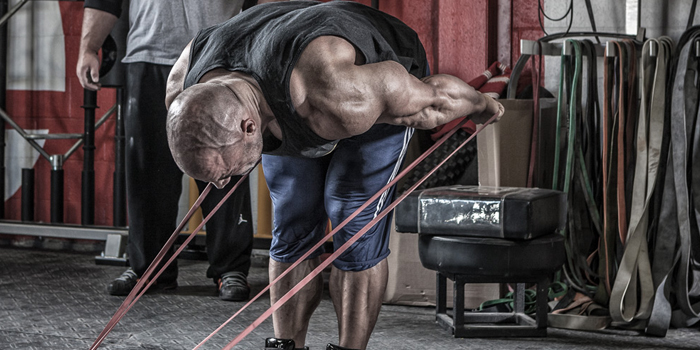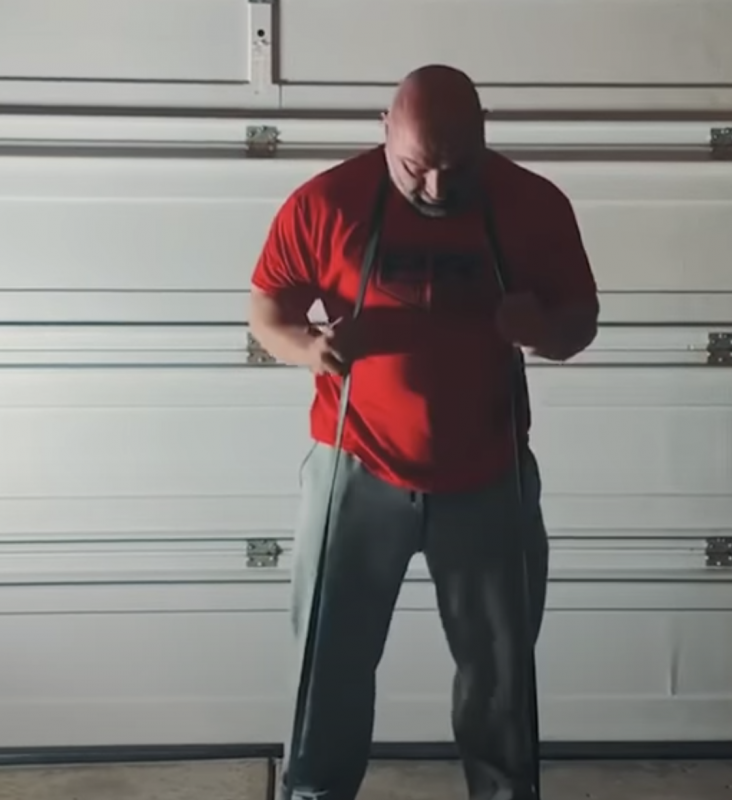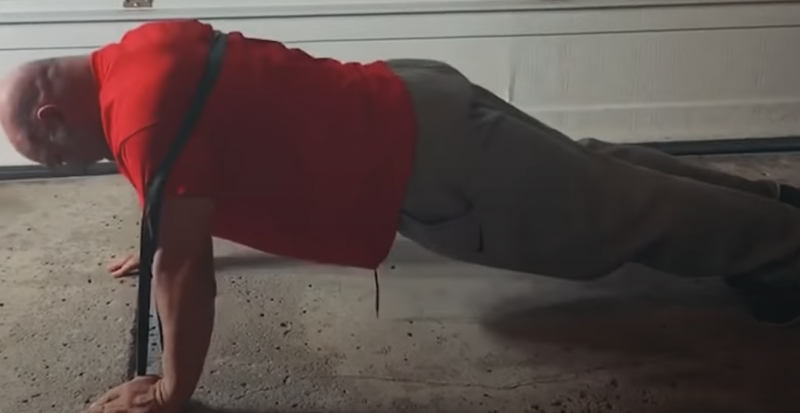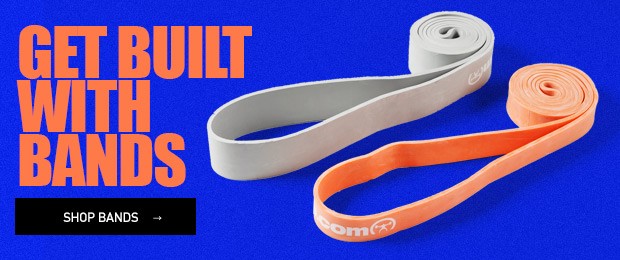
Bands may be added, as is commonly known, to all powerlifting movements; however, the constituents of this index are reserved for specific patterns that at best vaguely represent the big three. The intention of this article is not to promulgate the substitution of all barbell and dumbbell movements with bands, but rather, to serve as a guide for ancillary, accessory movements reserved for the final tiers of a session which typically address musculature pertinent to compound lifts to instigate accruals in performance and contemporaneously prevent injury, or even act as rehabilitative measures for attendant, adversely impacted musculature.
Discovering that the labrum of my right shoulder was torn in two spots, and my clavicle had hypertrophied to plausibly prevent a stress fracture, I discerned that while surgery was advisable, it is commonplace to require additional invasive procedures, due to the glenohumeral joint’s disposition, anecdotally speaking, to endure continual, frequent aggravation. Bearing the antecedent in mind, in conjunction with the fact that the deadlift and squat weren’t contraindicated, I forwent surgery, executing a great deal of banded shoulder movements within the confines of extensification strictures. The aforementioned served as the catalyst for my appreciation of the significance bands play in developing physicality, and the impetus for unearthing the seemingly ceaseless list of movements bands allot for.
RECENT: Why Are We Doing This?
Contained herein are in-depth analyses of movements I heavily depend on for augmenting my physical prowess on the mat, and for any athletes I coach irrespective of sport. The end of the index also includes patterns that can be executed with bands that many coaches adhere to with great success.
*Note that tempo is delineated within parentheticals throughout the article, separated into four sections, (Concentric/Isometric/Eccentric/Isometric), with the exception of Band Good Mornings, being (Eccentric/Isometric/Concentric/Isometric). An “X” denotes that specific fraction of the movement be executed as expeditiously as possible.

Good Mornings
Musculature that is both predominant in preventing injury and improving performance usually dominates the posterior compartments of the human body. The hamstrings, glutes, and erectors of the lower back are no exception. The unfortunate reality, however, is that many people cannot hip hinge correctly, despite cues from varying sources, and valuable time spent in earnest attempting to rectify the issue. Ultimately, coaches are left with no other option but to eliminate compound lifts that are axiomatically superlative at developing the posterior chain, such as SSB Good Mornings, and Romanian Deadlifts. Fortuitously, and for reasons I still cannot comprehend, the Banded Good Morning invariably assuages the predicament. Perhaps, due to placement of the load, and that the tension deloads during the eccentric action of the pattern, athletes are able to hinge exceptionally well with a band around the nape of their neck. Due to such, I have implemented Banded Good Mornings with a Blue Strong band at all levels of play.
While the parameters of the quantitative facets of the movement alter depending on the sport, and season, they are universally incorporated, and done so in conjunction with tempo-related increases over the course of each microcycle. Olympic collegiate rosters that tend to have a very low collective training age should focus on 3-4 sets of 4-6 repetitions with a progression in tempo. Over the course of a four-week wave, I will usually expose the team to repetition-related, and tempo-related progressions. A common 4-week block will appear as follows:
Micro 1: 4-Weeks; Band Good Mornings
| Week 1: | Week 2:Repetition-Related | Week 3:Tempo-Related | Week 4:Repetition-Related |
| 3x4 (2/1/X/1) | 3x5 (2/1/X/1) | 3x5 (3/1/X/1) | 3x6 (3/1/X/1) |
If you weren’t forced to justify your quantitative and qualitative selections to sports coaches, athletic trainers, and supervisors within the strength department, who tend to harbor reservations with concern to higher volume, then it would behoove the athletes you are responsible for to be progressed to upwards of 50-60 Band Good Mornings per week. Consequently, the above four-week block mutates into something quite different, explicated below.
Micro 1: 4-Weeks; Band Good Mornings
| Week 1: | Week 2:Adapt | Week 3:Overload | Week 4:Overload |
| 3x15 | 3x15 | 40 x As Few Sets as Possible (AFSAP) | 50 x AFSAP |
Micro 2: 3-Weeks; Band Good Mornings
| Week 5:Deload | Week 6:Overload, Beat the number of sets it took on week 4 | Week 7:Overload, Beat the number of sets it took on week 6 |
| 3x20 | 50xAFSAP | 50xAFSAP |
I personally know a Division-I collegiate strength coach who applied this philosophy with their swim team to great reward, achieving roughly 60 Band Good Mornings per week. Perhaps this seems excessive, yet professionals within the field inform us that a usual hypertrophy and endurance block of a linear macrocycle is restricted to 3-6 sets of 10-20 repetitions. If we applied the maximum allotted by the preceding, that would total 120 repetitions. The demand of 50 repetitions in one set pales in comparison.
Although a degree of reticence with concern to high volume posterior chain work is comprehensible, consider the amount of synergistic work the hip extensors must perform to prevent the hip flexors from inclining the trunk forward throughout the concentric phase of a squat. A successful squat, both the most fundamental and complex of movements, depends on significant synergy- or the harmony between separate muscle groups to purvey force in apt patterns to actualize the intended movement- between anterior and posterior compartments of the lower and upper bodies. Although the term posterior chain inspires banality within seasoned strength veterans for its overuse in discourse by even the laymen, its role in augmentation of sport performance, and longevity is unassailable. Whether it be strength sports, Olympic sports, combat sports, or football, there is sizeable hip extensor and knee flexor action that must be taken into account, and reflected in training, to fortify those patterns and pertinent musculature. Concerning injury prevention, for which strength coaches are on the front line, ligamentous and cartilaginous damage within the knee is mitigated through hamstring and glute training. In summation, as potent synergists, antagonists, and agonists, the hamstring and glutes should receive appropriately sizeable work within the strictures of any program.
Band Suggestions: Grey Average, Blue Strong.
Hamstring Curls- Unilateral or Bilateral
Time honored and proven, this knee flexor variant’s sophistication lies in its simplicity. One simply ties the band around a fixed object, sits at a height that puts the crease of the hip at roughly 90 degrees, and affixes the opposing end of the band around the Achilles. Begin with either both or one leg extended, a preference contingent upon time and intent, and simply curl your foot underneath the apparatus your seated on, preferably an elitefts Box Squat Box, as the room beneath the surface of the box allows you to enhance the range of motion bringing your foot further behind. A squeeze for a period of isometric activity is great for inducing hypertrophy, extending the time under tension, succeeded by a controlled eccentric. A (X/2/2/X) tempo is suggested to predicate your periodization of this movement on.
Micro 1: 4-Weeks; Unilateral Band Hamstring Curls
| Week 1: | Week 2:Repetition-Related | Week 3:Tempo-Related | Week 4:Repetition-Related |
| 3x5(X/2/2/X) | 3x6(X/2/2/X) | 3x6(X/3/2/X) | 3x7(X/3/2/X) |
While much of what was discussed, and expounded upon in the section explicating the Good Morning and its attendant benefits can be applied to this movement’s advantages, the hamstring curl has it's a purpose all its own. While the knee flexor action of the curl stands in contrast to the objective of hip extension in the Good Morning, it reduces any stress placed on the lumbar and its attendant musculature. Despite lower back strength being a massive contribution of the Good Morning to performance and longevity, some athletes, especially those in the collegiate realm, will take time to adjust to the soreness it induces, and complaints rendered about such can oft provide strength coaches with undue stress. Substituting Hamstring Curls for Good Mornings for a week within the microcycle can relieve their lower back, purveying time for resistance to build up within it to withstand further hip extension in subsequent weeks.
Often, these are done bilaterally with a light band for high repetition counts; however, unilateral movements serve a great purpose. Having conducted my Master’s thesis on the bilateral deficit, which is the phenomenon whereby the force exerted by individual limbs during bilateral movements is less than it is during unilateral force development, the momentousness of the specificity of muscle contraction type became quite apparent. While augmentations in performance are regarded to be a resultant of increased skill which is held to be apparent only during the movement one has trained- increases in bench press are due to, and visible only during, a bench press- specificity of muscle contraction type purports that as long as the movement is concentric and eccentric in nature, competitive maximum strength accruals will occur.
Consequently, through a case study concentrated on unilateral force production as a means of reduction of this deficit, with Alternating Dumbbell Bench Press as the independent variable, and the dependent variable being the bilateral Barbell Bench Press, the results displayed an increase in subjects’ Barbell Bench Press by a minimum of 5 pounds and a maximum of 30 pounds. Unilateral contractions have profound implications in performance accruals, not only for inciting accretions in bilateral horizontal pressing strength, but also for cross-education purposes. Athletes often endure the unfortunate reality of injuries, and the training of the injured limb is labeled contraindicated. Cross-education references the impact on hypertrophy and strength that the training of one limb has on the other, preventing atrophy and other undesirable consequences to the untrained limb. Therefore, not only will performing unilateral Hamstring Curls strengthen and hypertrophy the opposing limb, but also it will plausibly facilitate ameliorations in the bilateral deficit of corresponding limbs.
Band Suggestions: Red Mini, Green Monster Mini, Orange Light.
3-D Pull Apart
This banded movement is a prime example of a high repetition pattern for preventative, and rehabilitative intents. This movement targets more actions respective to the shoulder girdle than any other single exercise: horizontal abduction and adduction; upward rotation of the scapulae; protraction and retraction; elevation and resisted depression; and static flexion. A consequence of the sizeable amount of mechanical work recommended for this movement- dictated by fiber type of involved postural musculature, and shoulder health’s dependency on the cross-sectional area of the fiber- the middle and inferior trapezius, teres minor and infraspinatus, as well as, the posterior and medial deltoid receive noticeable accruals in size. The superior trapezius responds incredibly well to this as a result of its obligation to preclude depression of the scapulae throughout the duration of each set.
The 3-D Pull-Apart should be done with an Orange Micro, or Red Mini Band in accordance with repetitions in the range of 25-100. The implications of said repetition range not only comprise maximization of muscular endurance, but also incorporate augmentation of mass by means of inducement of sarcoplasmic hypertrophy. Physiological development in this regard enables contact sportsmen to absorb shock, and reinforces general shoulder stability, and longevity. If done with an Orange Micro, tempo the movement as follows, (X/1/1/X). If one utilizes a Red Mini Band, reach muscular failure without any applied tempo.
WATCH: 17 Band Exercises Powerlifters Can Do at Home
All other Pull-Apart Variants: You may use the bands listed below for all pull-apart mutations, whether they be pronated or supinated, directed toward the clavicle, sternum, or behind the head. Additionally, diagonal pulls work well for upward rotation of the scapulae in conjunction with retraction.
Commonly, my athletes and I will perform one giant set with an Orange Micro Band for a total of 240 repetitions, as follows:
Pronated Pull Aparts:
- Clavicle x40 Reps
- Sternum x40 Reps
- Diagonal Left x40 Reps
- Diagonal Right x40 Reps
- Behind-the-Head x40 Reps
Supinated Pull Aparts:
- Sternum x40 Reps
This giant set may be done with the Red Mini Band for 20 reps per movement, for a total of 120 repetitions.
Band Suggestions: Orange Micro, Red Mini.
Shrugs
Whether preparing for contact sports, or all strength sports, the superior trapezius is both a prominent, visually arresting feature that defines the yoke, and an indispensable muscle for pulling, squatting, pressing, and walking with load. The uni-planar elevation and depression of the scaps may be a source of banality for most, yet when done in repetitions upwards of 50 with an Average Band, or for sets of 20-25 with a Strong Band, one quickly observes the expeditious rate of growth the superior trap undergoes. Lower repetition options exist, for which tempo is of the utmost significance. Utilizing an elitefts Strong Band, shrug up with speed, hold for 2-seconds, lower for 1-second, and stretch for 2-seconds (X/2/1/2). 3-4 sets of 10 repetitions with this tempo will suffice. Sets equal to and exceeding 20 repetitions don't receive time constraints, as the intention of maximal mechanical work is maximal impact on metabolism and hypertrophy of the muscle. Prior to delving into further exercises constituting the remainder of the index, I would be remiss to omit that sarcoplasmic hypertrophy is the main objective of most movements within this article. While there are no actual accretions in density of the actin and myosin filaments, or accompanying muscle fiber strength from corresponding set and repetition parameters, there is significant growth of the interfibrillar substance (the sarcoplasm), synthesizing expansion of the cross-sectional area (CSA) of the fiber, causing overall optimization of its size. The shoulder is the weakest ball-and-socket joint, and is in desparate need of stability, which we gain through expansion of the muscle’s CSA.
Band Suggestions: Orange Light, Grey Average.
Lat Pulldowns
Universally implemented for their dependability with concern to myriad factors, pulldowns are relied upon primarily for their ability to add mass in a far more isolated fashion than their numerous horizontal and vertical pulling counterparts. The barbell bent-row is arguably the preeminent supplemental movement for building the squat, deadlift, and bench press, yet it requires a tremendous amount of isometric action on behalf of the hip extensors, and erector spinae. A properly executed pull-up demands sizeable glute and abdominal bracing. The one-arm dumbbell row, despite its indispensability as a supplemental tool, relies on lower-body stabilization, as well. Conversely, the lat pulldown is done seated, with far less technical nuances to attend to. The loose parameters regarding the movement’s technique, and lack of stabilization concerns specific to its counterparts, promotes high levels of mechanical work with negligible taxation on any other musculature outside of the elbow flexors, and grip.
Consequently, it may be performed on days where both collegiate athletes, and life-long lifters are either feeling well, or utterly, physically, taxed. Relying on a band as the implement to purvey resistance behests the lifter to pull with maximal velocity, and resist the elasticity of the implement during the movement’s yielding component. Bands also gift an element that bars do not- the option to pull slack out at the point of peak contraction. To pull not only down, but also out makes this a tremendous tool for muscular growth. In order to maximize its benefits, apply tempo, which may vary according to tension. (X/1/2/1) reflects my personal predilection for a high velocity pull, denoted by “X,” 1-second of isometric activity at the clavicle allowing enough time to pull the ends of the band away from one another, a 2-second negative, and a 1-second pause at the top to elicit the benefits on muscular growth from stretching the lats. Repetitions, as with any exercise, vary with the intent of that specific block of the overall macrocycle, training age, and biofeedback provided on that specific day. A general rule of thumb is to elevate yourself physically to eventually endure 100 repetitions, whether done consecutively for 1 set, or in 2 sets of 50.
The aforementioned is predicated on a number of variables, one of the most significant being whether lifting is supplemental to your sport, or is, in and of itself, the actual sport you practice. In relation to supplementing my primary objective of improving my physicality for Brazilian Jiu-Jitsu, I have found that 2 sets of 50, once per week, is sufficient for this specific exercise and muscular growth intents. Note that this does not constitute the entirety of my back training.
Band Suggestions: Grey Average, Blue Strong.
Terminal Knee Extensions (TKE)
Health of the knee joint has long been contingent on the development of the Vastus Medialis Oblique (VMO). Fortification of this muscle, referred to colloquially as the teardrop, remedies patellar-tracking predicaments, and serves as a preemptive tactic regularly employed with concern to the prevention of patellofemoral syndrome, common in endeavors such as cross-country. Postural in nature, the VMO’s development is reliant on high repetitions. Employment of Banded TKEs, with a Light, or Average Band, at the beginning or conclusion of a session is a matter of predilection. Evolutions of the TKE can be found in the elitefts Archives under “Buddy Morris 2005 Interview” which is an extremely informative series regarding a host of other concerns, as well, that are relative to our field.
The VMO is immanently postural, and therefore commands higher repetition totals to augment in size. Tempo only furthers time under tension, which, in the case of tonic musculature, is vital for growth; a muscle obligated to resist gravity by firing at low rates for high percentages of the day is resistant to expansion, requiring such high mechanical work. The succeeding sets, reps, and tempo should incite enlargement of relevant fibers. 2-3x20 (X/2/2/X). Emphasize the 2-second isometric action between concentric and eccentric actions.
TKE Squats, and other banded hip flexion/extension variants are available on elitefts’ YouTube channel within Mark Watts’s video which may serve as qualitative substitutes to the typical banded TKE, further avoiding accommodation, and stimulating adaptation.
Band Suggestions: Grey Average, Blue Strong.
Banded Dorsiflexion, Inversion, Eversion, Plantarflexion
Musculature responsible for the inversion, and eversion of the foot is significant for generating ground-force production in sprinting, and for eliminating ankle sprains. Dorsiflexion is arguably the preeminent means by which one may balance development of the lower compartment of the leg, and avoid predicaments listed below.
Due to myriad factors including, gait, over-development of the posterior lower leg compartment (triceps surae), and high mileage, the fascia of the tibialis anterior may begin to pull on the shin replicating pain commensurate with shin splints, if shin splints haven’t already occurred as a result of unbalanced work. Banded Dorsiflexion is certainly a remedy for the antecedent, forcing the athlete to contract at maximal rates throughout its concentric element, and resist the band’s elasticity throughout the eccentric fraction. Accentuating yielding work is the most vital component of these movements, as the ankle is predisposed to display of lack of control eccentrically. Each of the four movements of this giant set should adhere to the tempo of (X/2/3/X), conducted at the end of the training session. Typically, 2-3 sets of 10 should suffice in strengthening the attendant musculature.
Band Suggestions: Grey Average, Blue Strong.

Push-ups
In the field of collegiate athletics, hardly enough emphasis is placed on this relative strength movement, despite its ability to develop upper-body musculature, strength, and burgeon resistance to that provided by bodyweight in many athletic endeavors, including the takeoff in sprinting. It’s hard to find seasoned coaches who aren’t flabbergasted by the staggering inability on many athletes’ behalf to perform this bodyweight movement, despite proficiency in the bench press. Any dearth of ability in a gross motor pattern should be amended immediately, and adding bands, in this case, will keep repetition counts low to attenuate soreness, averting interference with on-field practice and play, all the while imparting the benefits of accommodated resistance: concentric velocity and movement intent; force development through lockout; lockout strength itself; accelerated eccentrics; the myotatic stretch reflex’s significance in improving the efficiency of the subsequent overcoming action.
While abstaining from any horizontal pushing patterns for over a year was mandatory to facilitate rehabilitation of my shoulder, I found that the work done with all pull-apart variants listed above had enveloped the glenohumeral structure in a supportive amount of muscle, enabling pushups to finally be administered without pain, or the typical clicking concomitant with labrum issues.
Although I have an appreciation for sets of extremely high repetition counts, I eventually required a tool to forward my abilities in the push-up, and elitefts bands were all I had, and ultimately needed, to foment strength accruals. The bands may be combined to purvey enough resistance to train maximally, reaping the neuromuscular rewards of maximal effort training in this less nuanced counterpart to the barbell bench. Henceforth, one can utilize enough band tension to stimulate improvements in intermuscular and intramuscular coordination, decrements in CNS inhibition, and its consequential effects on Motor Units, in conjunction with a movement that has a far less severe learning curve.
Micro 1:
| Week 1: | Week 2: | Week 3: | Week 4: |
| 6RMBW x6Light x6Average x6Strong x6 | 3RMBW x3Light x3Average x3Strong x3Strong and Light x3 | 6RMBW x6Light x6Average x6Strong x6Strong and Monster-Mini x6 | 3RMBW x3Light x3Average x3Strong x3Strong, and Average x3 |
Band Suggestions: Green Monster Mini, Orange Light, Grey Average, Blue Strong.
Additional Movements:
- Sit-Ups
- Upright Row
- Curls: Hammer, Pronated, Supinated
- Overhead Triceps Extensions: Hammer, Supinated
- Internal Rotation
- Side-Plank with Row
- Plank Row
- Scap Overhead Presses
- Spider Wall Walks
- Face Pull, Face Pull w/ External Rotation
- Retraction w/ Extension











Sorry, but your intellect and your need to exploit it forced me to seek articles from other authors concerning the topic in reference.
Go back and read Supertraining, if you ever did read it. Or read Muscle and Fitness and be content with rhetoric intended for the laymen, and "the masses."